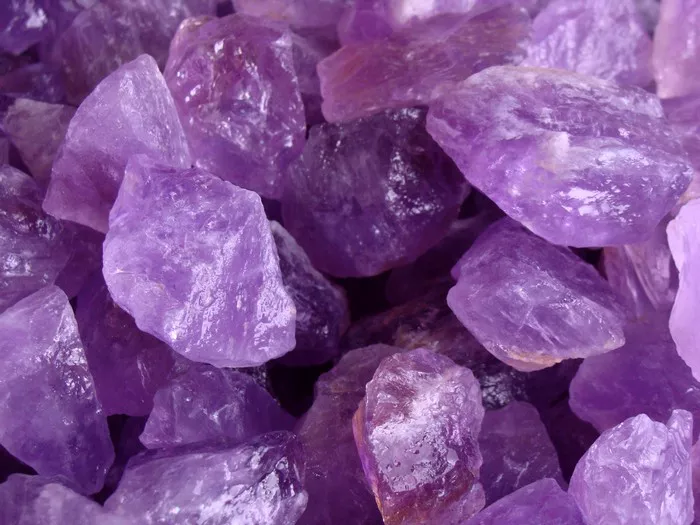Amethyst, with its regal violet hues and captivating crystalline structure, has enchanted humanity for centuries. Beyond its aesthetic allure, this gemstone holds intrinsic value that varies depending on a multitude of factors. Delving into the intricacies of amethyst valuation reveals a complex interplay of characteristics, origins, and cultural significance. In this comprehensive guide, we explore the question: How much is raw amethyst worth?
Legacy and Symbolism
Beyond its monetary value, amethyst carries a rich legacy steeped in symbolism and cultural significance. Revered for its spiritual properties, this gemstone has been associated with wisdom, protection, and enlightenment across various civilizations.
Throughout history, amethyst has adorned the regalia of royalty and clergy, symbolizing authority, purity, and divine connection. Its use in religious artifacts and talismans further underscores its esteemed status.
Moreover, amethyst is celebrated for its purported metaphysical properties, believed to enhance intuition, promote emotional balance, and ward off negative energies. This mystical allure continues to captivate enthusiasts and practitioners of alternative healing modalities.
One notable variation of amethyst is Ametrine, a rare gemstone that combines the hues of both amethyst and citrine. This unique blend symbolizes harmony, balance, and spiritual transformation, making it highly sought after by collectors and connoisseurs alike.
Factors Affecting Amethyst Value
Amethyst’s worth is influenced by several key factors, each contributing to its overall value:
Weight (Carat): Similar to other gemstones, the size of an amethyst stone significantly impacts its value. Larger stones generally command higher prices per carat, as they are rarer and often more visually striking.
Color and Saturation: The depth and richness of an amethyst’s color play a crucial role in determining its value. Stones with deep purple or blueish tones are considered more valuable, as they are perceived as more desirable and visually appealing.
Clarity: Clear, transparent crystals are highly sought after in the gemstone market. Stones with minimal inclusions or blemishes are preferred, as they exhibit greater brilliance and clarity.
Origin: The geographical origin of an amethyst can significantly influence its value. Certain localities, such as Brazil, Zambia, and Madagascar, are renowned for producing high-quality amethyst specimens prized for their exceptional color and clarity.
Cut: The manner in which an amethyst is cut also affects its value. Faceted or cabochon cuts, when executed skillfully, enhance the gemstone’s brilliance and allure, thereby increasing its worth.
Pricing Ranges
Determining the value of raw amethyst involves considering various factors, including its quality, color, clarity, and origin. Pricing can vary significantly based on these factors, with some units serving as benchmarks for valuation.
Per Carat: Amethyst prices range from $5 to $100 per carat, with higher-quality stones commanding premium prices.
Other Units: For larger quantities, the price of amethyst can be extrapolated as follows:
A gram of amethyst: $25 to $500
An ounce of amethyst: $709 to $14,175
A kilogram of amethyst: $25,000 to $500,000
A pound of amethyst: $11,340 to $226,796
A ton of amethyst: $22,679,625 to $453,592,500
Country of Origin
The country of origin also plays a significant role in determining the value of amethyst. Different regions produce amethyst of varying quality and characteristics, which are reflected in their respective price ranges:
Brazil: $2 to $40 per carat
Uganda: $25 to $200 per carat
Zambia: $30 to $100 per carat
India: $5 to $15 per carat
Madagascar: $10 to $30 per carat
Sri Lanka: $15 to $100 per carat
Siberia: $20 to $200 per carat
Afghanistan: $10 to $20 per carat
Color and Cut Specifics
In addition to origin, the specific color and cut of an amethyst can further influence its value. Here are some examples of pricing ranges based on color and cut:
Siberian Faceted: $15 to $100 per carat
Dark Cabochon: $15 to $20 per carat
Medium Faceted: $10 to $30 per carat
Medium Cabochon: $5 to $10 per carat
Light Faceted: $5 to $20 per carat
Blue (Any Cut): $40 per carat
Green (Any Cut): $5 to $50 per carat
Conclusion
In conclusion, the value of raw amethyst is determined by a combination of factors, including weight, color, clarity, origin, and cut. While pricing ranges can vary significantly depending on these variables, amethyst remains a highly prized gemstone coveted for its aesthetic appeal and cultural significance.
Whether viewed as a precious investment or cherished for its symbolic meaning, amethyst continues to enchant and inspire individuals around the world. By understanding the complexities of amethyst valuation, collectors and enthusiasts can appreciate the true worth of this captivating gemstone.


